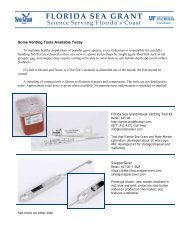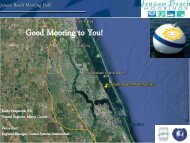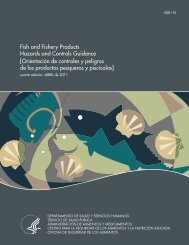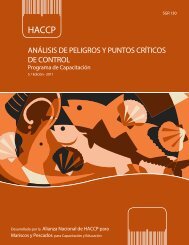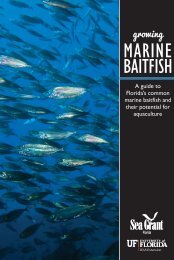HACCP
Hazard Analysis and Critical Control Point - Florida Sea Grant
Hazard Analysis and Critical Control Point - Florida Sea Grant
- No tags were found...
You also want an ePaper? Increase the reach of your titles
YUMPU automatically turns print PDFs into web optimized ePapers that Google loves.
Chapter 2<br />
Table 1 (cont.)<br />
2) Condition and cleanliness of food contact surfaces (FDA Key Sanitation Condition<br />
No. 2)<br />
Controls and Monitoring:<br />
a) Food contact surfaces are readily cleanable (do not have cracks, cavities, crevices,<br />
overlapping joints, mineral scale, etc. that are not possible to adequately clean and<br />
sanitize). The sanitation supervisor inspects food contact surfaces to determine if<br />
they are readily cleanable. Monitoring Frequency: Daily.<br />
b) Food contact surfaces are cleaned and sanitized:<br />
1) Before operations begin, food contact surfaces are rinsed with cold water<br />
and sanitized with a 100 ppm sodium hypochlorite sanitizer. The sanitation<br />
supervisor inspects food contact surfaces to determine if they are clean<br />
and have been wetted with sanitizer. Monitoring Frequency: Daily before<br />
operations begin.<br />
2) During breaks (every 4 hours), major solids are physically removed from<br />
floors, equipment, and food contact surfaces. All surfaces are rinsed with<br />
cold water. Food contact surfaces are scrubbed, using brushes with a<br />
chlorinated alkaline detergent in warm (≥120°F) water. All other surfaces<br />
and floors are rinsed with cold water. Food contact surfaces are sanitized<br />
with a 100-150 ppm chlorine as sodium hypochlorite sanitizer solution.<br />
Floors are sanitized with a 400-600 ppm quaternary ammonium chloride<br />
sanitizer. Utensils are cleaned in a deep sink with a warm chlorinated alkaline<br />
detergent, rinsed in warm water (≥120°F), and dipped in a 100 ppm chlorine<br />
as sodium hypochlorite sanitizer prior to use. The sanitation supervisor<br />
checks sanitizers before use and inspects food contact surfaces to<br />
determine if they are clean and have been sanitized. Monitoring Frequency:<br />
At the 4- and 8-hour breaks.<br />
3) At the end of daily operations, major solids are physically removed from<br />
floors, equipment, and food contact surfaces. Equipment is disassembled as<br />
required for adequate cleaning. All surfaces are rinsed with cold water. Food<br />
contact surfaces are scrubbed using brushes with a chlorinated alkaline<br />
detergent in warm (≥120°F) water. Floors and walls (splash zone) are washed<br />
with warm chlorinated alkaline detergent, using push brooms on floors. All<br />
surfaces are thoroughly rinsed with clear water before applying sanitizer.<br />
Food contact surfaces are sprayed with 100-150 ppm chlorine as sodium<br />
hypochlorite sanitizer solution. Floors and walls are sprayed with a 400-600<br />
ppm quaternary ammonium chloride sanitizer solution. Utensils are cleaned<br />
in a deep sink with a chlorinated alkaline cleaner in warm (≥120°F) water,<br />
dipped in a 100-150 ppm chlorine as sodium hypochlorite sanitizer and air<br />
dried. The sanitation supervisor inspects food contact surfaces to determine<br />
if they are clean and have been sanitized. Monitoring Frequency: Daily at<br />
the end of operations.<br />
c) Workers wear clean gloves and outer garments.<br />
1) Workers working with raw and cooked product wear clean gloves, clean<br />
outer garments, and waterproof aprons. Waterproof aprons are cleaned and<br />
sanitized twice each day, at the midday break and at the end of the shift.<br />
20



